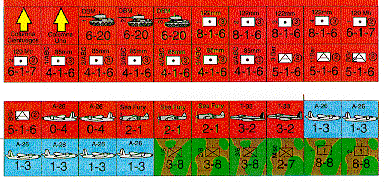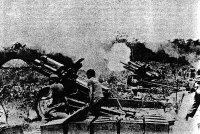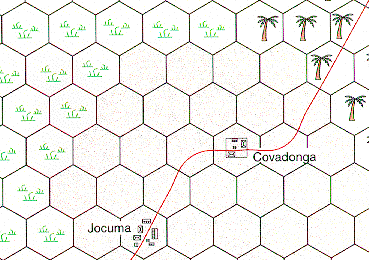|
|
|
|
Cuba Libre! In April of 1961 a force of Cuban exiles, trained and equipped by the American CIA, landed on the south coast of Cuba. The game covers the historical fighting around the resort of Playa Giron at the Bay of Pigs. Units are companies and battalions, with 1 km to the hex and 6 hours per turn. One 17 by 22 color map (in two 11 x 17 sections), 120 color counters, rules, option cards, charts and organization displays. Rules are included for Air to ship attacks, parachute drops, pilot fatigue, ranged fire support, ammo shortages, the FRD provisional government, and options such as US Marine intervention and world reaction. Designed by James Meldrum. $18.00 |
|

|

|

|
What the reviewers said: "Reflecting his substantial research, designer James Meldrum has captured both the ambience of the time and range of tactical options available to both sides in just seven pages of rules."
"Cuba Libre is a great sucess in combining high playability, crisp components, well-developed rules, and outstanding research in the definitive simulation of the Bay of Pigs invasion." --Doug Murphy in Paper Wars #31 |
|
Historical notes (from the rulesbook) Brigade 2506 was conceived by the CIA, during the waning year of the Eisenhower administration, as a way to replace the infant regime of Fidel Castro. Recruitment was done largely in southern Florida among refugees that had recently fled Cuba. Training bases were set up in Guatemala and Nicaragua, and equipment was purchased with covert CIA funds. Vice President Richard Nixon was briefed on the operation, and the planners assumed that he would win the November, 1960 presidential election. Eisenhower was ambivalent on the operation, while Nixon was strongly in favor of it.
In one of the closest elections in US history, John F. Kennedy defeated Nixon. President-elect Kennedy was briefed on the operation, and was undoubtedly concerned. During the campaign, he had repeatedly blasted the Eisenhower/Nixon administration for its "soft stance" on Cuba. Now he would have to inherit the solution. The CIA planners evolved several different plans. These ranged from 1) a continuation of the clandestine guerrilla war they were currently supporting in Cuba, 2) a landing of the Brigade as a large guerrilla army that could operate in the Escambray mountains of south-central Cuba, to 3) a full scale invasion that would declare a provisional government and immediately ask for US recognition and military assistance. As the months progressed, the planners decided that the third option was the best. The Bay of Pigs (Bahia de Cochinos) was chosen for several reasons. It was on the south coast of Cuba, and the invasion fleet would be sailing from Nicaragua, so landing on that side of the island would lessen appearances of direct US involvement. The areas was distant from the major populated areas, so that Castro's army and would not be able to interfere with the landings. The area was also isolated by the Zapata swamps, with only a few roads leading in or out of the area. A beachhead could be consolidated and easily defended. While the Brigade leaders were instructed to march north and "turn left to Havana," secretly it was realized by the CIA planners that the Brigade lacked sufficient force to overthrow the Castro regime immediately. Instead, the more realistic approach was to sustain the beachhead, fly in a provisional government, and gain US diplomatic recognition and military support. Once ashore, the new provisional government would issue a "call to arms" among the Cuban people, and provide weapons those that joined them. The CIA planners also assumed that they could force the president to react with diplomatic and military force once the Brigade was ashore. After all, they reasoned, he could not allow it to fail. Airstrikes by Brigade pilots flying A-26 bombers were to destroy Castro's airforce on the ground. The airstrikes on April 15 did destroy a number of planes. But, a far more dangerous message had been sent. Castro now realized that invasion was imminent. He dispersed his remaining planes and beefed up the anti-aircraft (AA) defenses. He also mobilized the militia, and ordered the arrests of all known dissidents. The 30,000 people rounded up and jailed included many of those that might have rallied to the Exile cause, and did include a number of actual resistance members. While the CIA handlers tried to obtain Kennedy's permission for a second airstrike, the Communists prepared for the invasion. CIA frogmen went ashore during the night of April 16/17, to lay out lights for the landing craft. They found that the approaches to the beaches were covered by sharp coral reefs and rocks, not smooth and sandy as was expected. As their boats approached the beach near Play Giron, they were "lit up" by headlights from a jeep. Several local militiamen then exchanged gunfire with them, and retired. More militia arrived in trucks and deployed. The frogmen fought back, laid out their lights, and waited for dawn. It was at first light that several problems became apparent. Playa Giron was not a sleepy, deserted fishing village. At least 180 new buildings had been constructed, and the grand opening of this new beach resort had already been set for May 20. Roads into and out of the area had been improved and paved. Apparently Playa Giron was one of Castro's favorite fishing spots, and he knew the area intimately! The CIA planners had determined that the nearest telephone was over 20 miles away, so an alert would take at least a day to go out. What they hadn't counted on was that the local militiamen had at least two radios and a relay tower, and Castro had been alerted even as the Brigade ships began to unload. Castro realized that this was the invasion whose hand had already been tipped by the airstrikes. He worked through the remainder of the night, coordinating the airforce to strike at dawn (personally talking to the pilots), and ordering army and militia units to move towards the area. Castro's personal direction, energy, and knowledge of the battle zone was to prove decisive in the next three days. The Brigade ships moved closer to the landing beaches and began to unload. Men and equipment poured ashore, even as Castro's militiamen fought back from buildings within Playa Giron. Most of the Brigade infantry was ashore by morning, except that the Fifth Battalion was held offshore as a floating reserve (it was the greenest unit). The Brigade airborne troops dropped near dawn, blocking off the main roads that Castro's forces would have to take to get to the beaches. Most of the airborne scattered widely, and lost much of their heavy equipment to the swamps. Disaster struck just after dawn. Castro's small airforce zeroed in on the larger ships sitting in the Bay. Rocket's fired from the Hawker Sea Furies scored hits on the Houston and the Rio Escondido. The Houston grounded and began to sink, while the Rio Escondido blew apart, sinking with ten days supply of food, ammo, and gasoline, as well as the Brigade communications trailer. The other ships pulled out of the Bay, hoping to avoid the same fate. Only 10% of the Brigade's ammo had been unloaded. The men of the unfortunate Fifth Battalion, onboard the stricken Houston, abandoned ship and swam to shore. The majority made it to the western side of the Bay, and were only able to organize small units. Most were captured over the next three days, unable to offer much organized resistance. Castro's forces moved into the area that day, concentrating north of Palpite near the Central Australia sugar mill and to the north and east of San Blas. The Brigade paratrooper roadblocks proved effective, and held out until their bazooka and .50 caliber machine gun ammo ran out. As the Communists were able to bring up artillery and tanks the situation worsened for the Exiles. Fighting was particularly savage at a traffic circle just outside Playa Larga known as "The Rotunda." Slowly the Brigade was forced to give ground, yielding Playa Larga and falling back towards Play Giron. The situation in the air was no better. The Brigade A-26's were no match for the planes of Castro's air force. Most of the A-26's had their tail guns removed, and extra fuel tanks added in order to make the flight from bases in Nicaragua. The Communists planes were closer to their airfields, and could spend more time in the air over the battlefield. Once the remaining Brigade ships had fled, they turned their attention to the troops on the ground. Meanwhile, Washington dithered. The CIA handlers had the Provisional Government ready to fly in, but the situation was still too "touch-and-go" to risk it. The CIA planners argued with the Joint Chiefs and the President. Kennedy was afraid of how the Soviets might react. He felt that the CIA had forced him into a no-win situation. The recriminations and finger-pointing began as the Brigade members paid dearly for this indecision. By the second day (the 18th) the Brigade defensive positions still included San Blas and Playa Giron, but Castro's forces were pressing in hard on both. As the Brigade heavy weapons ran out of ammo they had to be abandoned. Communist heavy artillery and tanks pounded their positions. By late afternoon on the third day (the 19th) the brigade was totally overwhelmed, with survivors taking to small boats and rafts. US Navy ships finally received permission to move in and pick up survivors. Small groups of men took to the swamps, but most were captured in the next few days. The aftermath was a political nightmare for Kennedy, and a field day for Castro. Eventually the US paid $53 million in ransom for the Brigade survivors. Of the total, 150 men had made it out, 1189 were ransomed, and 114 were KIA. Communists losses were exaggerated by both Brigade survivors and the CIA analysts and an accurate figure will never be know. Some estimates ran to over 1100, while the Cuban government admits to 154 KIA. The tourist museum at Playa Giron features captured weapons, disturbing photographs, and a Sea Fury. In Florida, anti-Castro sentiment still fuels Miami politics. Historical notes, counter art, and map art are ©1998 Randy Moorehead |
|
|
|
|